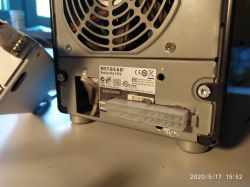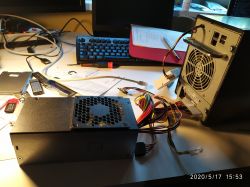Hello colleagues

And I took a different route - I tried earlier, I made a small 1-disk nasa from an HP terminal with a 2.5 "SATA disk inserted.
It has proven itself over several years of work.

Later I got my hands on the disposal Netgear ReadyNAS NVX - a 4-disk solid mechanical construction. The investigation showed that the power supply is faulty.
The original Netgear power supply available on Amazon costs half a fortune, and I wasn't sure if only this was damaged.
After a short search, it turned out to be an ordinary PC power supply with the usual 20-pin motherboard connector, but the witty designers swapped
a few pins in places. So I put a 24pin to 20pin power adapter into the housing with appropriately crossed cables:

The whole thing is not impressive, but it works and allows you to use a regular PC power supply:

I didn't like the original Netgear soft very much, so I built my own.
I don't need the GUI and the gimmicks, I hate it when the device does something out of control and I don't know what's going on underneath, I prefer to have full control.
The main task is backup, the rest are add-ons.
My soft is not very friendly - the whole configuration has to be done from the console manually (vi or nano

), but I know what's squeaking in the grass.
I lost XRaid (Netgear's own idea) but replaced it with unionfs, which has pretty much the same effect - except manual configuration.
Services available:
ssh
ftp / sftp
www with CGI
appletalk
samba
And of course, access via serial console

Nothing prevents you from adding whatever your heart desires.
The whole system boots to RAM, no element of it is placed on the matrix disks (unless expressly requested).
To synchronize files with the computer I used the open source SyncThing program - amazing, it allows local and WAN synchronization, everything happens in the background.
System boot screenshot below:
SYSLINUX 3.31 2006-09-25 Copyright (C) 1994-2005 H. Peter Anvin
Loading kernel..................................................
Loading rootfs.gz...............................................................................
.......................................................................................................
.....................................................................................................
Ready.
�ahci 0000:03:00.0: masking port_map 0x7 -> 0x3
ln: /dev/log: Fidevpts: called with bogus options
le exists
Starting syslogd OK
Starting acpid OK
Starting klogd OK
Starting mdev dynamic device management OK
Loading Kernel modules for LCD
nvxgpio: OK
Waiting for USB drive(s) to become ready..
sd 5:0:0:0: [sde] Assuming drive cache: write through
sd 5:0:0:0: [sde] Assuming drive cache: write through
sd 5:0:0:0: [sde] Assuming drive cache: write through
sd 6:0:0:0: [sdf] Assuming drive cache: write through
sd 6:0:0:0: [sdf] Assuming drive cache: write through
sd 6:0:0:0: [sdf] Assuming drive cache: write through
Found 4 SATA drives and 2 USB drives: sde sdf
Using external USB drive sdf
Mounting /dev/sdf1 on /mnt OK
Creating temporary config dir on tmp OK
Copying config files to temporary dir OK
Copying config files to /etc OK
Initializing random number generator... OK
Starting Auto assemble RAID
Waiting for /etc/mdadm.conf to be restored
Waiting for /etc/mdadm.conf to be restored
/etc/mdadm.conf not found. Trying to auto-assemble
Config updated
Scanning Auto assemble RAID OK
Starting network:
Bringing up interface lo OK
Bringing up interface eth0 OK
Bringing up interface eth1 OK
Bringing up interface bond0 OK
Setting time zone to Europe/Warsaw
Starting Network time protocol daemon OK
Activating swap OK
Starting Mount all storage devices
Check if /dev/disk/by-label/BIGDATA exists OK
Creating mountpoint /home: OK
Mounting BIGDATA (/dev/md1p1) on /home OK
Setting options for /home:
WARNING: Skiping option defaults
Check if /dev/disk/by-label/DATA0 exists OK
Mountpoint /var/www exists
Mounting DATA0 (/dev/sda3) on /var/www OK
Setting options for /var/www:
WARNING: Skiping option defaults
Check if /dev/disk/by-label/SMALLDATA exists OK
Creating mountpoint /var/backup: OK
Mounting SMALLDATA (/dev/md0p1) on /var/backup OK
Setting options for /var/backup:
WARNING: Skiping option defaults
Changing mode to 0770 OK
Changing group to 102 OK
Starting Dropbear ssh server OK
Netatalk service - MacIntosh connectivity disabled in config
Syncing hardware clock with system clock: OK
Cron scheduler daemon disabled in config
Starting Smartd monitoring daemon OK
Hiawatha web server disabled in config
Pure-ftpd sever disabled in config
Starting SMB service OK
Starting NMB service OK
Running all Local scripts (rc.local functionality)
Absolutely useless front panel demo ;-) disabled in config
Starting Syncthing - continuous sync program OK
+=====================================================+
| _ __ _ __ |
| /\/\ (_) ___ _ __ ___ /\ \ \ /_\ / _\ |
| / \ | | / __|| '__|/ _ \ / \/ ///_\\ \ \ |
| / /\/\ \| || (__ | | | (_) |/ /\ // _ \_\ \ |
| \/ \/|_| \___||_| \___/ \_\ \/ \_/ \_/\__/ |
| |
| by Szubi (gimbus109@gmail.com) |
| http://second.zmienneip.pl/hacking |
+=====================================================+
bond0: 192.168.101.5
eth0:
eth1:
MicroNAS login: root
Password:
# free
total used free shared buff/cache available
Mem: 2072440 135868 1351004 0 585568 0
-/+ buffers/cache: 135868 1936572
Swap: 4194296 0 4194296
As you can see, the system is 135MB with 2GB in RAM.
At the moment www, ftp and netatalk services are disabled in the configuration, but enabling them does not change the memory usage.
The whole thing has been running for several months, but it is still "Work In Progress" -
recently I added a menu that allows you to view important system status items on the LCD display - disk status and occupancy, RAID status, etc.
I offer all kinds of assistance to those who are interested

best regards






